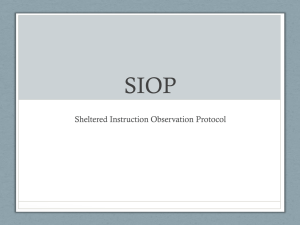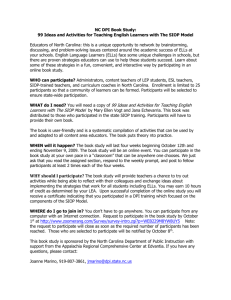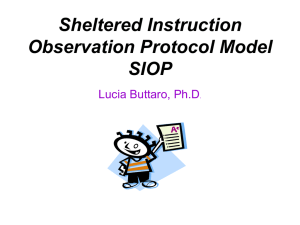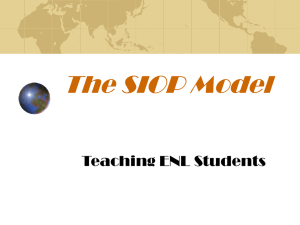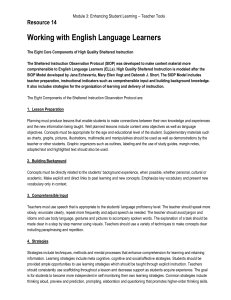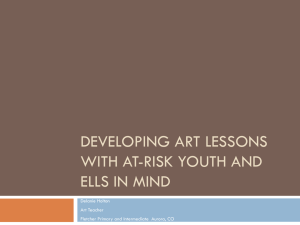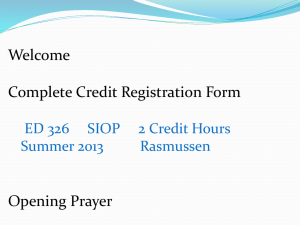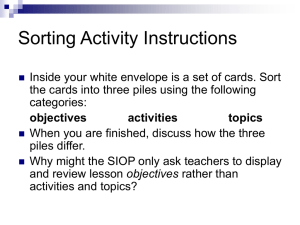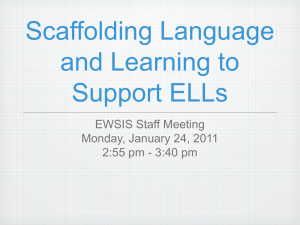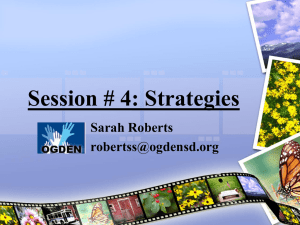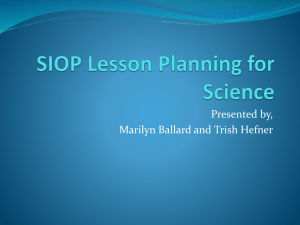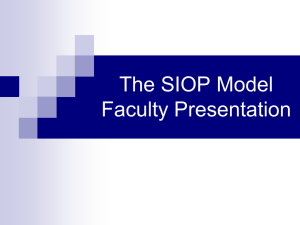Making Content Comprehensible for English Language Learners
advertisement
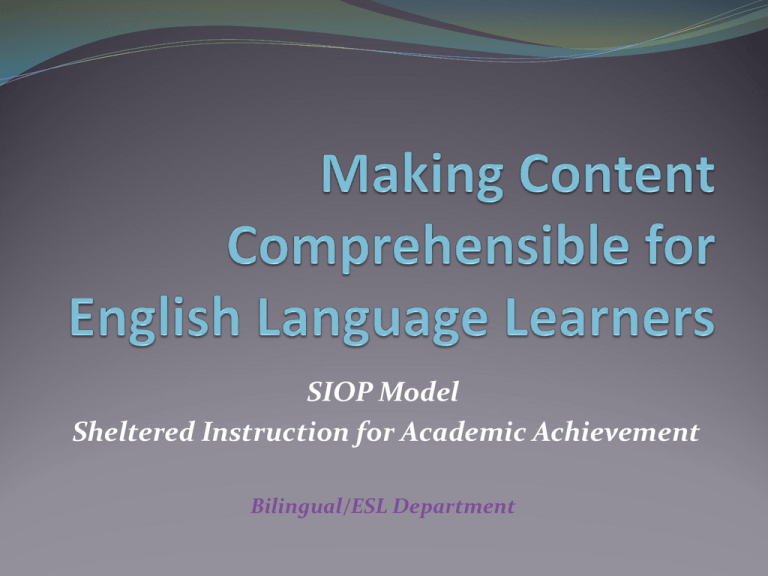
SIOP Model Sheltered Instruction for Academic Achievement Bilingual/ESL Department The Challenges Providing content area instruction that is accommodated to the needs of ELLs at all levels Integrating academic language instruction into content area instruction High expectations for academic success of ELLs in all content areas Definition of Sheltered Instruction A variety of strategies, techniques, and materials for making grade-level core curriculum (reading, science, social studies, math) more accessible for English Language Learners while at the same time promoting their English language development. What is SIOP? Purposefully teaching of the language necessary for English Language Learners to understand the content. The SIOP Model The Eight Components of SIOP (Echevarria, Vogt, & Short, 2008) Preparation Building Background Comprehensible Input Strategies Interaction Practice & Application Lesson Delivery Review & Assessment The SIOP Model shares many features recommended for high quality instruction for all students, such as: cooperative learning strategies for reading comprehension emphasis on the writing process differentiated instruction accommodates the distinct second language development needs of ELLs The SIOP Model contains key features for the academic success of ELLs, such as the: inclusion of language objectives in every lesson development of background knowledge acquisition of content-related vocabulary emphasis on academic literacy practice allows for some variation in classroom implementation http://vidego.multicastmedia.com/player.php?p=wzsf4417 Ensuring rigor and relevance Objectives clearly defined content objective (TEKS) write on board state orally clearly defined language objective (ELPS) write on board state orally *Students need to know what they will be learning and how they will be learning it How can I lessen the gap? How can I differentiate? Adaptation of Content Supplementary Materials Adaptation of Content to all levels of student proficiency (B,I,A,AH): Make texts accessible to all students without “watering down” differentiating same content objective, different input/output/process scaffolding adjusting content to various learning styles and intelligences Examples of Adaptation of Content Thinking Maps/Graphic Organizers – schematic visuals that help students grasp the “wholeness and parts” of a concept Outlines – help students take notes in an organized manner Highlighted Text – highlighted key concepts, important vocabulary and summary statement in text helps reduce stress yet maintains key concepts Marginal Notes – notes in the margins help focus attention on important ideas, key concepts, key words and definitions or important supporting facts Examples of Adaptation of Content Taped Text – allows for multiple exposures to text which improves reading and understanding Adapted Text – helps students get access to the same text, but with shorter, simpler sentences they can comprehend better Leveled Study Guides – guides that accompany textbooks that may include: a summary of the text, leveled questions, important facts, etc… Supplementary Materials Use supplementary materials to make the lesson clear and meaningful support core curriculum make content concepts “concrete”: tangible, visible, understandable contextualize learning make it real support learning styles support multiple intelligences Examples of Supplementary Materials Hands-on manipulatives and realia – connects abstract concepts with concrete experiences and student’s own life Pictures, Photos, Visuals – provide support for harder concepts Multimedia – film clips, songs and chants, posters, computer games, etc… - related to concept solidify concepts into the students’ deep memory Demonstrations – model step-by-step completion of tasks or model language to use with presentations – scaffolds and enhances learning Related materials – leveled books both fiction and nonfiction that supplement the theme of what is being taught http://vidego.multicastmedia.com/player.php?p=ttygb29a Building Background 1) Link concepts to students’ background experiences Discuss students’ previous personal and academic experiences to help bridge meaning 2) Bridge past learning to new concepts Integrate new information with what the learner already knows 3) Emphasize key vocabulary The most effective way to teach vocabulary is when it is presented in the context of new concepts, not in isolation Students should be actively involved in their own vocabulary development and make it personal Students should be immersed in a vocabulary-rich environment Focus on key vocabulary: contextualizing key vocabulary vocabulary self-selection personal dictionaries content word wall concept definition map cloze sentences word sorts word generation visual vocabulary vocabulary through songs http://vidego.multicastmedia.com/player.php?p=d832qs79 What is Comprehensible Input? 3 Features of Comprehensible Input Clear explanation of academic tasks Speech appropriate for students’ proficiency level Variety of techniques used to make content concepts clear Comprehensible Input Explanation of Academic Tasks • present instructions in a step-by-step manner and/or with demonstrations • peer modeling Scaffolding • verbal scaffolding – paraphrasing, think-alouds, reinforcing contextual definitions • procedural scaffolding explicit teaching modeling practicing applying Comprehensible Input Questioning – using a variety of question types Interaction variety of grouping structures (partners, triads, teams, etc…) vary group configurations from day to day Wait time (effective teachers wait 20 seconds or more – ELLs may need longer than that) Clarifying key concepts in first language – allow students to confer with each other, teacher, or paraprofessional in their native language about subject matter to support understanding Comprehensible Input Application of content and language knowledge (projects) discussing and doing make abstract concepts concrete reporting out orally (opportunity to practice English) Integration of language skills – develop reading, writing, listening and speaking in an integrated manner Review of key vocabulary – multiple exposures to new vocabulary Assessment of lesson objectives using multiple methods http://vidego.multicastmedia.com/player.php?p=d7y4u441 Strategies Metacognitive Thinking About Thinking! Cognitive Active Learning! Questioning Techniques Higher-Order Thinking! Social/Affective Interactive Learning! Scaffolding Techniques Building Independence! Metacognitive Strategies “thinking about your thinking” predicting/inferring self-questioning monitoring/clarifying evaluating summarizing visualizing Cognitive Strategies “active learning” previewing/rereading establishing a purpose for reading making connections reading aloud highlighting taking notes mapping information finding key vocabulary mnemonics Social/Affective Strategies “interactive learning” interaction/questioning cooperative learning group discussion/self talk i.e.. think/pair/share Teacher Behaviors The Big Picture Building Background Self-Correcting Self-Evaluation Peer Interaction Imitation Native Language Resources Avoid: Avoid: Avoid: Focus on: Focus on: Focus on: Discovering Main Focus on: Wait prior prior time Ideason: correcting Assuming Longthe Clarification Avoid: Focus knowledge knowledge Avoid: Focus on: student students will Teaching reading Essential Always Context ‘Phone a Yes orgiving no knowAvoid: how to students Only grading Journals (can Focus on: the answer friend’, ‘poll the questions! clues assignments Details their foruse correct be illustrated!) when and to Silent audience’ Listen Relating KWL 6-8 new dictionaries answers to radio use Charts classrooms how the Pairing shared and words these Rubrics Interviews higher & lower experiences glossaries resources level ELLs Guest Speakers Assuming Lectures Avoid: Immediately A Model of Scaffolding TeacherCentered TeacherAssisted PeerAssisted StudentCentered Lecture Drill & Practice Role Playing Rehearsal Strategies (repeated readings) Direct Instruction Discovery Learning Peer Tutoring Elaboration Strategies (imagery) Demonstration Brainstorming Reciprocal Teaching Organizational Strategies (graphic organizers) Recitation Discussion Cooperative Learning Strategies Graphic Organizers Comprehension Strategies Rehearsal Strategies GIST PENS SQP2RS Mnemonics Surveying (scanning the text) Questioning (teacher guided, students generate questions) •Prediction Predicting (stating 1-3 things Preview ideas • Summarization Process learned based •Self-questioning on their questions) Explore words • Main(searching Idea Reading for answers Note words in a complete •Monitoring and• Topic confirming predictions) sentence Sentences A memory system Responding •Determining (answering questions importance Seeoften if theinvolving sentence is • Flash cards visualization andcorrect ornew acronyms and formulating ones for the • Summarizing Please Excuse My Dear Sally • Underlining next Aunt section) Summarizing (oral or written • Note-taking summary of key concepts) http://vidego.multicastmedia.com/player.php?p=da46imyr Teacher comment: “My content is so packed that I can’t cover everything if I allow student talk. Lecture is the best way to ensure I’m where I need to be to complete all objectives before the test”. Opportunities for Interaction 1) Learning is more effective when students have an opportunity to participate fully – discussing ideas and information 2) Effective teachers strive to provide a more balanced linguistic exchange between themselves and their students – ELL students need to practice speaking 3) Interaction accesses the thought processes of another and solidifies one’s own thinking 4) Talking to others, either in pairs or small groups allows for oral rehearsal of leaning Opportunities for Interaction encourage more elaborate responses vary grouping configurations (random, voluntary, teacher assigned) whole group, flexible small groups, partners/triads homogeneous/heterogeneous (gender, language proficiency, ability, etc…) allow adequate wait time – don’t allow yourself or other students to answer their questions clarify concepts in L1 if needed – teacher or peers clarify concepts or use native text, dictionaries or other tools http://vidego.multicastmedia.com/player.php?p=s408co4e Key Definitions: “Practice” refers to the opportunities provided to English Language Learners to become familiar, analyze and/or experiment with content and language topics. “Application” refers to the ways in which learners apply what they have learned in different contexts or situations. Practice and Application: Tools: Hands-on materials and/or manipulatives Language and content knowledge-rich activities Language skills- integrated activities Purpose: For students to practice with new content knowledge For students to apply learning in the classroom For students to develop reading, writing, listening and speaking skills http://vidego.multicastmedia.com/player.php?p=d44s00i8 LESSON DELIVERY FEATURES Content Objectives should be clearly supported by the lesson delivery (stated orally - written on board for all to see) Language Objectives should be clearly supported by the lesson delivery (stated orally - written on board for all to see) LESSON DELIVERY FEATURES Class time needs to be planned efficiently - all aspects of student engagement should be considered: well planned lessons clear explanations of academic task or instructions appropriate amount of time to spend on academic task strong classroom management opportunities for students to apply learning in meaningful ways active student involvement lesson design that meets the language and learning needs of students Students should be engaged approximately 90-100% of the time during the lesson (engagement minimizes boredom and off-task behaviors) Pacing of the lesson should be appropriate to the students’ ability level (brisk enough to maintain students’ interest, but not too quick to lose their understanding) http://vidego.multicastmedia.com/player.php?p=vfmu984j Review Provide comprehensive review of key vocabulary teach, review, assess, use word study notebooks content word walls Supply comprehensive review of key content concepts review content directly related to the objectives throughout the lesson use graphic organizers as review Regularly give feedback to students on their output clarify discuss correct responses Assessment - Evaluation • Assessment is “gathering and synthesizing of information concerning student learning” • Evaluation is “making judgments about students’ learning” Assessment Informal Assessment • • on-the spot, on-going opportunities to determine the extent of students’ learning includes: teacher observations, anecdotal reports, informal conversations with students, quick writes Assessment Authentic Assessment application to real life – real life contexts multi-dimensional portfolios student’s writings taped pieces interviews videotapes observations projects discussions performances Assessment (cont.) includes multiple indicators to show competency of a content objective – use of a rubric group responses agree/disagree, true/false, yes/no index cards – happy face – sad face on a stick thumb up - down stand up – sit down numbered wheels dry erase response boards English Language Learners "If the child is not learning the way you are teaching, then you must teach in the way the child learns." - Rita Dunn
